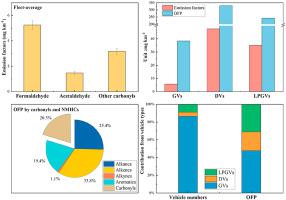Atmospheric Environment ( IF 5 ) Pub Date : 2021-05-26 , DOI: 10.1016/j.atmosenv.2021.118491 Zhenfeng Wu , Yanli Zhang , Chenglei Pei , Zuzhao Huang , Yujun Wang , Yanning Chen , Jianhong Yan , Xiaoqing Huang , Shaoxuan Xiao , Shilu Luo , Jianqiang Zeng , Jun Wang , Hua Fang , Runqi Zhang , Sheng Li , Xuewei Fu , Wei Song , Xinming Wang

|
Carbonyls play a vital role in atmospheric photochemistry. Vehicle emission is among most important primary emission sources of carbonyls in urban areas, yet knowledge is quite scarce about real-world emissions of carbonyls with the changing on-road vehicle fleets. In this study, emissions of carbonyls were characterized based on tests in a busy urban tunnel in south China. Emission factor (EF) of carbonyls was measured to be 9.89 ± 0.65 mg km−1 on average, in which formaldehyde alone shared 53.1% with an EF of 5.25 ± 0.35 mg km−1, followed by acetaldehyde with an EF of 1.47 ± 0.13 mg km−1. Glyoxal and methylglyoxal showed identical EFs of 0.18 ± 0.02 mg km−1. Multiple linear regression retrieved total carbonyl EFs of 5.68, 47.71 and 35.09 mg km−1 and ozone formation potentials (OFPs) of 38.4, 329.3, and 242.4 mg km−1 for gasoline, diesel and liquefied petroleum gas vehicles (LPGVs), respectively. The unexpectedly high carbonyl emissions from LPGVs were largely attributed to the lack of after-treatment systems or the inefficiency of the after-treatment systems. Among vehicle-emitted non-methane hydrocarbons and carbonyls, carbonyls could contribute ~20% of the total OFPs while they only accounted for 7.1% of the total mass.


























 京公网安备 11010802027423号
京公网安备 11010802027423号